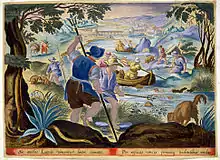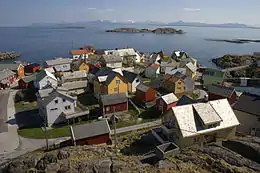Portofino
Portofino (Italian pronunciation: [ˌpɔrtoˈfiːno]; Ligurian: Portofin [ˌpɔɾtuˈfiŋ]) is an Italian fishing village and holiday resort famous for its picturesque harbour and historical association with celebrity and artistic visitors.[3][4] It is a comune located in the Metropolitan City of Genoa on the Italian Riviera. The town is clustered around its small harbour, and is known for the colourfully painted buildings that line the shore.[5]
Portofino | |
|---|---|
| Comune di Portofino | |
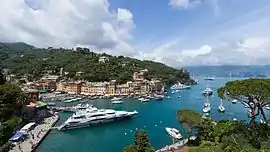 View of Portofino | |
 Coat of arms | |
Location of Portofino 
| |
 Portofino Location of Portofino in Italy 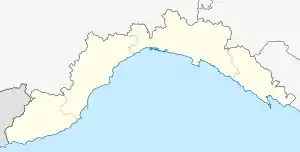 Portofino Portofino (Liguria) | |
| Coordinates: 44°18′14″N 9°12′28″E | |
| Country | Italy |
| Region | Liguria |
| Metropolitan city | Genoa (GE) |
| Government | |
| • Mayor | Matteo Viacava |
| Area | |
| • Total | 2.6 km2 (1.0 sq mi) |
| Elevation | 4 m (13 ft) |
| Population (31 December 2011)[2] | |
| • Total | 439 |
| • Density | 170/km2 (440/sq mi) |
| Demonym(s) | Portofinesi |
| Time zone | UTC+1 (CET) |
| • Summer (DST) | UTC+2 (CEST) |
| Postal code | 16034 |
| Dialing code | 0185 |
| Patron saint | St. George |
| Saint day | St. George's Bonfire: April 23rd. Religious Celebration the first Sunday after. |
| Website | Official website |
History
Pliny the Elder (AD 23 – AD 79) referred to Portus Delphini (Port of the Dolphin) as on the Ligurian coast between Genoa and the Gulf of Tigullio.[6]
The village is mentioned in a diploma from 986 by Adelaide of Italy, which assigned it to the nearby Abbey of San Fruttuoso di Capodimonte. In 1171, together with the neighbouring Santa Margherita Ligure, it was included in Rapallo's commune jurisdiction. After 1229 it was part of the Republic of Genoa. The town's natural harbour supported a fleet of fishing boats, but was somewhat too cramped to provide more than a temporary safe haven for the growing merchant marine of the Republic of Genoa.
In 1409 Portofino was sold to the Republic of Florence by Charles VI of France, but when the latter was ousted from Genoa the Florentines gave it back. In the 15th century it was a fief of families such as the Fieschi, Spinola, Adorno, and Doria.
In 1815 it became part of the Kingdom of Sardinia and, from 1861, of the unified Kingdom of Italy.
In the late 19th century, first British, then other Northern European aristocratic tourists began to visit Portofino, which they reached by horse and cart from Santa Margherita Ligure. Aubrey Herbert and Elizabeth von Arnim were amongst the more famous English people to make the area fashionable.[7] Eventually, more expatriates built expensive vacation houses, and by 1950 tourism had replaced fishing as the town's chief industry, and the waterfront was a continuous ring of restaurants and cafés.
Main sights
- Statue of Christ of the Abyss, placed underwater on 29 August 1954 in the inlet at a depth of 17 metres (56 ft). This statue was placed to protect fishermen and scuba divers and in memory of Dario Gonzatti, the first Italian to use SCUBA gear, who died in 1947. Sculpted by Guido Galletti, it represents Christ in the act of blessing while looking up towards the sky with open arms in a sign of peace.
- Castello Brown (16th century).
- Church of St. Martin (Divo Martino, 12th century).
- Church of St. George, housing some saints' relics.
- Oratory of Santa Maria Assunta, in Gothic style.
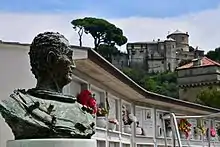
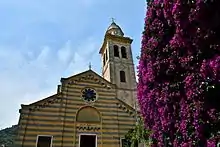
In popular culture
- The Enchanted April, a 1922 best-selling novel by Elizabeth von Arnim based on the author's stay in Castello Brown, is credited with making Portofino fashionable.[8] The novel was the basis of a 1991 feature filmed in the Castello, with a cast including Joan Plowright, Miranda Richardson and Alfred Molina. The film was nominated for three Oscars.[9]
- Portofino is often thought to be the inspiration for Sir Clough Williams-Ellis' Italianate village named Portmeirion, built between 1925 and 1975, in north Wales. However, this was repeatedly denied by the architect. He stated only that he wanted to pay tribute to the atmosphere of the Mediterranean. He did, however, draw on a love of the Italian village, stating "How should I not have fallen for Portofino? Indeed its image remained with me as an almost perfect example of the man-made adornment and use of an exquisite site."[10]
- In 1959 Dalida released song "Love in Portofino", written by Leo Chiosso and composed by Fred Buscaglione. With lyrics in French and Italian language, it became a hit and was later iconized alongside the village's name. It also spawned several international covers, including Andrea Bocelli's in 2013 which was followed by a concert recorded and issued on DVD.
- Portofino is the eponym of Frank Schaeffer's Portofino: A Novel (1992). It was the first of Schaeffer's Calvin Becker Trilogy.[11]
- Portofino is one of the shooting locations of the 1995 Antonioni / Wenders film, Beyond the Clouds.[12]
- There is a full-scale replication, in authentic detail, of Portofino Bay at Universal Orlando Resort in Orlando, USA, which opened in September 1999.
- Portofino inspired in 2001 a recreation of the seaside town in the Mediterranean Harbor area at Tokyo DisneySea in Chiba, Japan. It also served as the namesake for the restaurant Cafe Portofino.
- Portofino was also featured in 2008 for the television series Top Gear (Episode 5, Series 12). Richard Hammond, in a Ferrari Daytona raced James May in a carbon fibre powerboat from Portofino to St Tropez in France.
Notable residents
- King Richard I of England (1157-1199), in 1190[13]
- Pope Gregory XI (1330-1378), in 1377
- Henry Herbert (1831-1890), British Politician
- Guy de Maupassant (1850-1893), French writer
- Guglielmo Marconi (1874-1937), Italian engineer, inventor of radio
- Giuseppe Amisani (1879-1941), Italian painter
- Michele Cascella (1892-1989), Italian painter
- Rex Harrison (1908-1990), English actor
- Lilli Palmer (1914-1986), German actress, wife of Rex Harrison
References
- "Superficie di Comuni Province e Regioni italiane al 9 ottobre 2011". Istat. Retrieved 16 March 2019.
- All demographics and other statistics: Italian statistical institute Istat.
- Italy. "Italy: Portofino guide". Telegraph. Retrieved 2013-01-11.
- Ross, Rory (2007-09-01). "Portofino: a port town that has evaded the uglier side of tourism - Europe - Travel". The Independent. Retrieved 2013-01-11.
- Lonely Planet, Portofino Guide, accessdate=2015-03-24.
- Pliny the Elder, Natural History, III, VII, 2
- De Vere White, Terrence. Introduction to The Enchanted April, Virago: 1991. ISBN 9780860685173.
- De Vere White, Terence in introduction to 'The Enchanted April', Virago: 1991
- "Enchanted April". Internet Movie Database.
- Headley, Gwyn, and Meulenkamp, Wim. Follies: a National Trust Guide Cape, 1986. p.156
- Schaeffer, Frank. Portofino: A novel. New York: Macmillan. ISBN 978-0-7867-1716-3.
- "Beyond the Clouds (1995) Filming Locations". IMDB. Retrieved 2013-12-14.
- Hofmann, Paul (1994-06-19). "Portofino, For the Rich And Less So". The New York Times. Retrieved 2015-02-28.
- https://en.db-city.com/Italy--Liguria--Genova--Portofino
External links
 Portofino travel guide from Wikivoyage
Portofino travel guide from Wikivoyage- Portofino
- Portofino tourism
- City Hall
- Portofino Natural Park
- Virtual tour, Marine
- Love in Portofino song on YouTube

